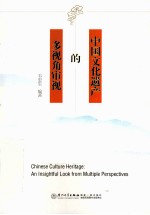

中国文化遗产的多视角审视 英文版PDF电子书下载
- 电子书积分:12 积分如何计算积分?
- 作 者:韦忠生编著
- 出 版 社:厦门:厦门大学出版社
- 出版年份:2010
- ISBN:9787561537220
- 页数:339 页
Chapter One Understand Culture 1
1.1 The Definition of Culture 1
1.2 Layers of Culture 4
1.3 Differences between Cultures:High and Low Context Communication 4
1.4 Measuring Cultural Differences 5
1.5 Cultural Ethnocentrism 8
1.6 Models of Culture 8
1.7 Characteristics of Culture 13
1.8 Approaches to Culture from Different Perspectives 16
1.9 Cultural Competence 23
1.10 Cultural Intelligence 24
1.11 The Process of Developing Cultural Intelligence 26
1.12 Activities That Support the Development of Cultural Intelligence 27
1.13 Cross-Cultural Interactions at Home 28
Chapter Two Understand Chinese Culture from Different Perspective 29
2.1 The General Characteristics of Chinese Civilisation and Culture 29
2.2 An Examination of Traditional Chinese Culture 31
2.3 A Comparision of Chinese Values and Westem Values 42
2.4 Four Principles of Chinese Culture 47
2.5 The Role of Writing in the Formation of Chinese Civilisation and Culture 49
2.6 The Conditions of Civilisation and Its Relation with Culture 50
Chapter Three Ancient China's Four Great Inventions—The Backbone of Chinese Culture 54
3.1 China-A Land of Inventions and Discoveries 54
3.2 Joseph Needham and History of Science and Technology in China 57
3.3 China's Four Great Inventions and Their Impact on the World 59
3.4 Features of Ancient Chinese Science and Technology 65
3.5 Scientific and Technological Classics 67
3.6 Reasons for Scientific and Technological Stagnation:Different Perspectives 76
Chapter Four Historical Background for Chinese Culture—the Prerequisite of Chinese Culture 80
4.1 The ancient period(ancient times—1840) 80
4.2 The modem period(1840-present) 104
Chapter Five An Insightful Look into Various Aspects of Chinese Culture:Chinese Architecture 123
5.1 Three Stages of China's Architecture History 123
5.2 Characteristics of Ancient Chinese Architecture:Different Perspective 124
5.3 Basic Architectural Elements 126
5.4 The Curved Roof:Practical and Aesthetic Consideration 128
5.5 Symbolism in Chinese Architecture 129
5.6 Comparisons Between Ancient Chinese City Planning and European Counterparts 130
5.7 Religious Impact on Ancient European Architecture and Its Features 134
5.8 Fujian(Yongding)Earth Buildings:A Typical Example of Local Residential Architecture 136
Chapter Six An Insightful Look into Various Aspects of Chinese Culture:Chinese Garden,Potted Landscapes and Tea 150
6.1 A Brief History of Chinese Garden 150
6.2 Classification and Distribution of Chinese Gardens 151
6.3 The Principles of Chinese Garden Design 152
6.4 The Common Structures and Basic Features of Chinese Gardens 153
6.5 The Aesthetic Features of Chinese Gardens 158
6.6 Differences Between Chinese and Western Gardens 160
6.7 Potted Landscapes:Penjing 160
6.8 A Brief History of Potted Landscapes 161
6.9 Categories,Materials and Patterns of Potted Landscapes 162
6.10 Schools of Potted Landscaping 164
6.11 Artistic Characteristics of Potted Landscapes 164
6.12 Appreciation of Potted Landscapes 166
6.13 Chinese Tea Culture 167
Chapter Seven An Insightful Look into Various Aspects of Chinese Culture:Silk & Chinese Culinary Art 182
7.1 History of Silk 182
7.2 The Family of Silkworm 183
7.3 The Secret of Sericulture 184
7.4 Characteristics of Silk 185
7.5 Trade Culture and Cultural Exchange on the Silk Road 185
7.6 A Secret out to the World 188
7.7 The Silk Road's Decline 189
7.8 Routes of the Silk Road in China 189
7.9 Some Main Sites along the Route 190
7.10 Culinary Culture 191
Chapter Eight An Insightful Look into Various Aspects of Chinese Culture:Traditional Chinese Painting & Calligraphy 205
8.1 Chinese Painting 205
8.2 Similarities and Differences Between Chinese and Western Painting 205
8.3 Classification of Chinese Paintings and Their Characteristics 208
8.4 Calligraphy and Painting 210
8.5 Symbolism in Chinese Painting 210
8.6 Approaches to Appreciate Chinese Painting 213
8.7 Chinese Calligraphy 218
Chapter Nine An Insightful Look into Various Aspects of Chinese Culture:Folk Beliefs in Chinese and Western Culture 224
9.1 Superstitious Beliefs as Components of Culture 224
9.2 Some Popular Chinese Folk Belief 225
9.3 Some Popular Western Folk Beliefs 234
Chapter Ten Managing Across Culture 249
10.1 Forces of Globalisation 249
10.2 Globalisation of People 249
10.3 How Cross-Cultural Communication Works 250
10.4 Understand Cultural Differences around the World 252
10.5 The CW Model:Another Cultural Perspective 254
10.6 The Globe Study:A Massive Cultural Project 258
10.7 Different Cultures and Management Systems 263
10.8 Cultural Influence on Business Setting 266
10.9 The Impact of Culture on International Negotiations 270
10.10 Cultural Approaches to Negotiation 280
10.11 A Probe into Leadership Styles 284
10.12 Leadership Styles in Real Life 286
10.13 The Components of Effective Leadership 286
10.14 Culture—Specific Business Practice 288
Chapter Eleven The Integration,Conflict and Translation of Culture,and the Future of Chinese Culture 299
11.1 Cultural Diffusion 299
11.2 The Cultural Integration and Impact of Chinese Culture on Other Countries 301
11.3 Cultural Conflicts 307
11.4 Two Orientations to Conflict 308
11.5 Value Differences and Conflict Styles 311
11.6 Managing Intercultural Conflicts 312
11.7 Dealing with Cultural Conflicts 313
11.8 The Translation of Culture 314
11.9 Cultural Imperialism and Chinese Culture's Future 316
11.10 Certain Reflections on Chinese Culture Translation in Global Cultural Context 319
11.11 Chinese Culture's Promising Future 320
Reference 332
- 《信息系统安全技术管理策略 信息安全经济学视角》赵柳榕著 2020
- 《大学英语教学的跨文化交际视角研究与创新发展》许丽云,刘枫,尚利明著 2020
- 《卓有成效的管理者 中英文双语版》(美)彼得·德鲁克许是祥译;那国毅审校 2019
- 《AutoCAD 2018自学视频教程 标准版 中文版》CAD/CAM/CAE技术联盟 2019
- 《跟孩子一起看图学英文》张紫颖著 2019
- 《改革进程中的刑事诉讼程序与证据问题研究 基于警察的视角》谢波 2019
- 《走出抑郁与焦虑 中西医视角下的心身同治》杨红琳 2019
- 《AutoCAD机械设计实例精解 2019中文版》北京兆迪科技有限公司编著 2019
- 《文化转向视角下的英汉翻译问题再审视》王燕著 2020
- 《复分析 英文版》(中国)李娜,马立新 2019
- 《市政工程基础》杨岚编著 2009
- 《家畜百宝 猪、牛、羊、鸡的综合利用》山西省商业厅组织技术处编著 1959
- 《《道德经》200句》崇贤书院编著 2018
- 《高级英语阅读与听说教程》刘秀梅编著 2019
- 《计算机网络与通信基础》谢雨飞,田启川编著 2019
- 《看图自学吉他弹唱教程》陈飞编著 2019
- 《法语词汇认知联想记忆法》刘莲编著 2020
- 《培智学校义务教育实验教科书教师教学用书 生活适应 二年级 上》人民教育出版社,课程教材研究所,特殊教育课程教材研究中心编著 2019
- 《国家社科基金项目申报规范 技巧与案例 第3版 2020》文传浩,夏宇编著 2019
- 《流体力学》张扬军,彭杰,诸葛伟林编著 2019
- 《大学计算机实验指导及习题解答》曹成志,宋长龙 2019
- 《大学生心理健康与人生发展》王琳责任编辑;(中国)肖宇 2019
- 《大学英语四级考试全真试题 标准模拟 四级》汪开虎主编 2012
- 《大学英语教学的跨文化交际视角研究与创新发展》许丽云,刘枫,尚利明著 2020
- 《复旦大学新闻学院教授学术丛书 新闻实务随想录》刘海贵 2019
- 《大学英语综合教程 1》王佃春,骆敏主编 2015
- 《大学物理简明教程 下 第2版》施卫主编 2020
- 《大学化学实验》李爱勤,侯学会主编 2016
- 《中国十大出版家》王震,贺越明著 1991
- 《近代民营出版机构的英语函授教育 以“商务、中华、开明”函授学校为个案 1915年-1946年版》丁伟 2017
